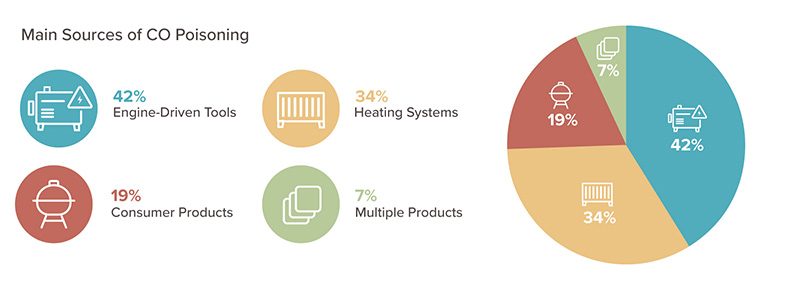If Carbon Monoxide is Present Will Detector Continue Go Off
What Does a Carbon Monoxide Detector Do and How Does it Work?
It might seem like a time-saver to run your car in the garage before a long commute, especially on a cold winter's morning. But the emissions from your vehicle can fill your garage with carbon monoxide (CO)—a dangerous, silent threat—even if the garage door is open.
Carbon monoxide is a colorless, odorless, and poisonous gas that claims over 430 lives a year.1
It's a byproduct of burning carbon fuel like the natural gas in your stove and the gasoline in your car. Even small doses of carbon monoxide can cause permanent damage or death.
What does a CO detector do?
Subscribe to our Youtube channel and learn how to protect your home, loved ones, and belongings.
About carbon monoxide
What is carbon monoxide?
Carbon monoxide gas (CO gas) is a simple molecule: one part carbon and one part oxygen. Carbon monoxide comes when carbon fuel—like wood, gasoline, coal, propane, natural gas, and heating oil—fails to burn completely (incomplete combustion).
These energy sources aren't dangerous when you burn them in an open area with plenty of ventilation. But carbon monoxide is hazardous in confined spaces—like basements, kitchens, garages, or campers.
Carbon monoxide is hard to detect without a sensor, which is one of the reasons it's so dangerous.
Sources of carbon monoxide gas
There are several common sources of carbon monoxide gas:
- Fuel-burning appliances like heating systems or water heaters
- Consumer products like grills
- Engine-driven tools like generators

Image source: safewise.com
Why is carbon monoxide dangerous?
Carbon monoxide is deadly because it binds with your red blood cells and starves your body of oxygen after passing into your lungs.
These are the early symptoms of carbon monoxide poisoning:
- Headache
- Nausea
- Vomiting
- Dizziness
- Shortness of breath
- Fatigue
Perhaps most troubling is the similarity to cold or flu-like symptoms that are easy to ignore—shortness of breath, nausea, and mild headaches. Disorientation and unconsciousness can occur when levels of carbon monoxide reach 150 parts per million (ppm).2 Eventually, the symptoms turn lethal without treatment.
How can I prevent carbon monoxide poisoning?
Carbon monoxide poisoning is a serious risk, but fortunately, it's preventable. Stop CO sources and be prepared.
Here are five carbon monoxide safety tips for avoiding exposure, including installing CO sensors throughout your home:
- Never heat your home with a gas range. Gas stoves produce carbon monoxide and can fill your home with dangerous gas.
- Don't run your car in the garage. Pull out of the garage first if you want to warm up your vehicle in the winter. Carbon monoxide is a common byproduct of vehicle exhaust and builds up quickly in a closed (or even open) garage.
- Always have proper ventilation. It's extremely dangerous to run gas-powered tools (like generators, space heaters, and pressure washers) in an enclosed area like a basement or garage without adequate ventilation.
- Practice cooking safety while camping. You should enjoy the wilderness safely. Don't use a charcoal grill, hibachi, or camping stove inside your home, tent, or camper. Besides, open flames and fabric tents don't tend to get along.
- Install a carbon monoxide detector. The best carbon monoxide detectors are affordable, easy to install, and can save your life. We recommend installing one on every level of your home, near each bedroom and garage, to test the air quality.
Detecting carbon monoxide
How do you detect carbon monoxide?
Carbon monoxide detectors are the fastest way to prevent CO poisoning. In your home, you can install a carbon monoxide alarm (or multiple detectors). They work much like your fire or smoke alarm by sounding a siren when they detect carbon monoxide.
You can find simple models like the Kidde Nighthawk and Alert Pro that set off a siren, or smart detectors like the Google Nest Protect* that connect to your smartphone or home security system.
Mid-2021, Kidde voluntarily recalled two of its combination smoke and carbon monoxide alarms. Our recommendation isn't one of those alarms.
How do carbon monoxide detectors work?
Carbon monoxide detectors sound an alarm when they sense a certain amount of carbon monoxide over time. Different sensors set off different types of alerts:
- Biomimetic sensor: a gel changes color when it absorbs carbon monoxide, and this color change triggers the alarm.
- Metal oxide semiconductor: when the silica chip's circuitry detects carbon monoxide, it lowers the electrical resistance, and this change triggers the alarm.
- Electrochemical sensor: electrodes in a chemical solution sense changes in electrical currents when they come into contact with carbon monoxide, and this change triggers the alarm.
Once the carbon monoxide detector alarm sounds, it must be in a carbon monoxide-free environment to silence the siren.
When will my carbon monoxide detector go off?
The CO alarm sounds if your sensor detects a buildup of carbon monoxide in your home—usually before you start sensing symptoms. With a low CO level (50 ppm), it may take up to eight hours for the alarm to go off. Higher carbon monoxide levels (over 150 ppm) can trigger an alarm within minutes.3
Act quickly when an alarm sounds because low doses over long periods can be just as dangerous as sudden carbon monoxide exposure in ultra-high doses.
What do I do if my carbon monoxide detector goes off?
- First, don't panic. Gather everyone in your house and move outside for fresh air and to avoid further CO exposure.
- On the way outside, open as many doors and windows as possible to help air out your home. To reduce exposure, don't go out of your way to open every door and window, just the ones along the way.
- Know the difference between an actual alarm and the detector's "end of life" alarm, which has a different sound.
- Survey everyone's health and check for any flu-like symptoms that could suggest poisoning.
- If you notice any symptoms, call 911 immediately.
- If possible, do not reenter your home until the alarm stops sounding or emergency responders deem your home safe.
- Contact a professional to evaluate every fossil fuel-burning appliance (particularly furnaces, boilers, water heaters, and stoves) and any other possible source of carbon monoxide to prevent a future incident.
Regular maintenance and inspections can help prevent safety hazards in your home, like a faulty furnace or fireplace.
Choosing a carbon monoxide detector
What kind of carbon monoxide detector should I get?
Overall, carbon monoxide detectors sense CO fast and alert you as soon as they do. But there's a surprising amount of variety in today's carbon monoxide sensors.
Some simple models plug into outlets or use a battery and alert you with a loud siren, like the one on your smoke detector. These models are cheap and suitable for multi-room buildings that need several units spread throughout.
Many models include sensors for both smoke and carbon monoxide. These are easy options you can swap out your existing smoke detectors for. They also reduce the number of sensors on your walls or ceilings.
You can also find smart models that connect with your home security system or alert you of danger through a mobile app. These models are expensive but can be a wise investment if you want extra safety for kids and pets at home.
You can learn more about CO detectors and how they work in our FAQ guide.
Where should I place a carbon monoxide detector?
Ensure everyone in the house can hear when an alarm goes off by placing a CO sensor in or near each of three critical locations in your home:
- At least one on each level—including the basement and attic
- Near each bedroom or sleeping space
- By doors that lead to attached garages
Follow your local laws and the manufacturer's instructions for additional guidance beyond these three locations (for example, some states require sensors in utility rooms). For more information, you can also check out our guide on the best places to install CO monitors.
How many carbon monoxide detectors do I need?
First, find out if your local laws require carbon monoxide detectors inside every enclosed sleeping area in a dwelling unit. In these cases, you need a sensor for every bedroom.
Most states require sensors within a certain distance of bedrooms, so a single sensor in a shared hallway can cover multiple bedrooms. This overlaps with the "one-sensor-per-level" rule.
Check out our best carbon monoxide detectors buyers guide to find one that fits your needs.
Related articles on SafeWise
Sources
- Centers for Disease Control and Prevention, "Carbon Monoxide Poisoning (CO)," March 23, 2022. Accessed July 29, 2022.
- United States Consumer Product Safety Commission, "Carbon Monoxide Questions and Answers." Accessed July 29, 2022.
- Kidde, Fire Safety, "What Are the Carbon Monoxide Levels That Will Sound the Alarm?," October 2019. Accessed July 29, 2022.
- National Fire Protection Association, "Carbon Monoxide Alarms." Accessed July 29, 2022.
Disclaimers
Product prices and availability are accurate as of the date/time indicated and are subject to change. Any price and availability information displayed on Amazon at the time of purchase will apply to the purchase of this product. Safewise.com utilizes paid Amazon links.
Certain content that appears on this site comes from Amazon. This content is provided "as is" and is subject to change or removal at any time.
†Google, Google Nest, Google Assistant, and other related marks are trademarks of Google LLC.
Compare the top home safety products
Data as of post date. Offers and availability may vary by location and are subject to change. SafeWise uses paid Amazon links.
†Google and Google Nest Secure are trademarks of Google LLC.
Recent Articles
Back To Top
cauthenfrenjudipt70.blogspot.com
Source: https://www.safewise.com/home-security-faq/carbon-monoxide-detector/

0 Response to "If Carbon Monoxide is Present Will Detector Continue Go Off"
Post a Comment